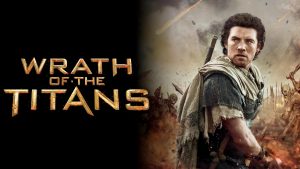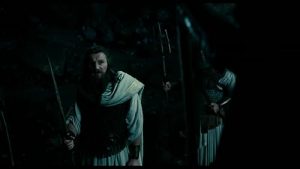“Wrath of the Titans” (2024)
“Wrath of the Titans” (2024) is a high-octane fantasy action film and the sequel to “Clash of the Titans” (2010). The story continues the adventures of Perseus (Sam Worthington), who is now living a quiet life as a fisherman with his son. When the ancient gods are threatened by the resurgence of the Titans, led by Kronos (Ralph Fiennes), Perseus is drawn back into a world of gods and monsters. To save the world, he must embark on a perilous quest to the underworld and battle mythical creatures, uncover ancient secrets, and confront his own destiny.
 Jonathan Liebesman’s direction is characterized by fast-paced action sequences and a focus on visual spectacle. The storytelling emphasizes grand set pieces and epic battles, which are central to the film’s appeal. While the narrative follows a familiar quest structure, it is infused with elements of mythology and fantasy that aim to captivate audiences. The film’s pacing is brisk, often prioritizing action and visual effects over deeper character development or complex plotting. The storytelling is straightforward, allowing viewers to focus on the action and mythical elements.
Jonathan Liebesman’s direction is characterized by fast-paced action sequences and a focus on visual spectacle. The storytelling emphasizes grand set pieces and epic battles, which are central to the film’s appeal. While the narrative follows a familiar quest structure, it is infused with elements of mythology and fantasy that aim to captivate audiences. The film’s pacing is brisk, often prioritizing action and visual effects over deeper character development or complex plotting. The storytelling is straightforward, allowing viewers to focus on the action and mythical elements.
 Sam Worthington returns as Perseus, delivering a solid performance that balances heroism with personal stakes. His portrayal is earnest, though his character does not undergo significant development. Liam Neeson and Ralph Fiennes reprise their roles as Zeus and Hades, respectively, bringing gravitas and depth to their performances. Rosamund Pike joins the cast as Andromeda, providing a strong supporting role that complements the lead characters. Toby Kebbell and Edgar Ramirez also contribute to the film with their performances, though the emphasis on action often overshadows their roles.
Sam Worthington returns as Perseus, delivering a solid performance that balances heroism with personal stakes. His portrayal is earnest, though his character does not undergo significant development. Liam Neeson and Ralph Fiennes reprise their roles as Zeus and Hades, respectively, bringing gravitas and depth to their performances. Rosamund Pike joins the cast as Andromeda, providing a strong supporting role that complements the lead characters. Toby Kebbell and Edgar Ramirez also contribute to the film with their performances, though the emphasis on action often overshadows their roles.
 The production values are a highlight of “Wrath of the Titans.” The film features impressive visual effects and stunning set designs that bring the mythical world to life. The action sequences are well-choreographed, with elaborate battles and creative depictions of ancient monsters. The cinematography captures the grandeur of the film’s landscapes and the intensity of its fight scenes. The musical score, composed by Javier Navarrete, enhances the epic tone of the film and complements the visual spectacle.“Wrath of the Titans” explores themes of heroism, fate, and the clash between gods and Titans. The film’s entertainment value is rooted in its action-packed sequences, mythological elements, and visual effects. While it may not offer deep thematic exploration or character development, it succeeds in providing an engaging and visually appealing experience for fans of fantasy and action genres. The film’s focus on spectacle and adventure ensures that it remains entertaining and immersive.
The production values are a highlight of “Wrath of the Titans.” The film features impressive visual effects and stunning set designs that bring the mythical world to life. The action sequences are well-choreographed, with elaborate battles and creative depictions of ancient monsters. The cinematography captures the grandeur of the film’s landscapes and the intensity of its fight scenes. The musical score, composed by Javier Navarrete, enhances the epic tone of the film and complements the visual spectacle.“Wrath of the Titans” explores themes of heroism, fate, and the clash between gods and Titans. The film’s entertainment value is rooted in its action-packed sequences, mythological elements, and visual effects. While it may not offer deep thematic exploration or character development, it succeeds in providing an engaging and visually appealing experience for fans of fantasy and action genres. The film’s focus on spectacle and adventure ensures that it remains entertaining and immersive.
 The film received mixed to positive reviews from critics, with praise for its visual effects and action sequences, but criticism for its plot and character development. It was generally well-received by audiences looking for an entertaining fantasy adventure with impressive visuals. While “Wrath of the Titans” may not be remembered for its narrative depth, it is appreciated for its ability to deliver thrilling action and immersive fantasy elements.“Wrath of the Titans” is a visually striking and action-packed fantasy film that continues the story of Perseus and his battles against mythological threats. Directed by Jonathan Liebesman, it excels in creating grand visual effects and engaging action sequences. While the film’s focus on spectacle may come at the expense of more nuanced storytelling and character development, it offers an entertaining experience for fans of epic fantasy and action. Its legacy lies in its ability to deliver an immersive and thrilling adventure in the world of Greek mythology.
The film received mixed to positive reviews from critics, with praise for its visual effects and action sequences, but criticism for its plot and character development. It was generally well-received by audiences looking for an entertaining fantasy adventure with impressive visuals. While “Wrath of the Titans” may not be remembered for its narrative depth, it is appreciated for its ability to deliver thrilling action and immersive fantasy elements.“Wrath of the Titans” is a visually striking and action-packed fantasy film that continues the story of Perseus and his battles against mythological threats. Directed by Jonathan Liebesman, it excels in creating grand visual effects and engaging action sequences. While the film’s focus on spectacle may come at the expense of more nuanced storytelling and character development, it offers an entertaining experience for fans of epic fantasy and action. Its legacy lies in its ability to deliver an immersive and thrilling adventure in the world of Greek mythology.
